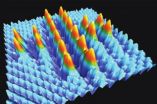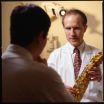(Press-News.org) Irradiation with heavy ions is suitable in particular for patients suffering from cancer with tumours which are difficult to access, for example in the brain. These particles hardly damage the penetrated tissue, but can be used in such a way that they deliver their maximum energy only directly at the target: the tumour. Research in this relatively new therapy method is focussed again and again on the exact dosing: how must the radiation parameters be set in order to destroy the cancerous cells "on the spot" with as low a damage as possible to the surrounding tissue? The answer depends decisively on the extent to which the ions can be decelerated by body tissue on their way to the tumour. Scientists of the Physikalisch-Technische Bundesanstalt (PTB) have established an experiment for the more exact determination of the stopping power of tissue for carbon ions in the therapeutically relevant area which is so far unique worldwide. Although the measurement data so far available must still become more exact, the following can already be said: The method works and can, in future, contribute to clearly improving the dosing for cancer therapy with carbon ions. The first results have recently been published in the magazine "Physics in Medicine and Biology".
Human tissue mainly consists of water. It can, therefore, be simulated well in liquid water in which form accelerated ions can be stopped on their way and at which target they deliver their maximum energy quantity – at least theoretically, because up to now experimental data has existed only for water vapour. Scientists, however, assume: If the aggregate state is neglected, the data determined for the determination of the radiation dose become too imprecise.
Within the scope of the doctoral thesis of J. M. Rahm, PTB scientists have now succeeded for the first time in determining the stopping power of liquid water for carbon ions with kinetic energies in the range of the maximum energy dissipation by experiment. The first results actually indicate that carbon ions are less strongly stopped in liquid water, related per molecule, than in water vapour. As soon as more exact data are available, the findings will be included in the calibration of ionization chambers which are used to determine the dose in therapy planning. At present, the Heidelberg Ion-Beam Therapy Center (HIT) is the only institution in Europe which irradiates patients with heavy ions.
The procedure applied by the researchers is based on a method which originates from nuclear physics: the Inverted Doppler Shift Attenuation Method. While the carbon ions excited by a nuclear reaction move through the water volume, they are stopped and fall back into their ground state. The energy distribution of the gamma quanta emitted thereby is recorded with the aid of an ultra-pure germanium detector. The Doppler effect, which leads to the displacement of the gamma energy, and the exponential-decay law allow the development of the velocity of the carbon ions with time to be pursued and, thus, conclusions on the stopping process to be drawn.
INFORMATION:
How strongly does tissue decelerate the therapeutic heavy ion beam?
PTB has developed a method for the more exact dosing of heavy ion irradiation in the case of cancer
2014-07-15
ELSE PRESS RELEASES FROM THIS DATE:
New hope for treatment of Alzheimer's disease
2014-07-15
Montreal, July 15 2014 - Judes Poirier, PhD, C.Q., from the Douglas Mental Health Institute and McGill University in Montréal (Canada) and his team have discovered that a relatively frequent genetic variant actually conveys significant protection against the common form of Alzheimer's disease and can delay the onset of the disease by as much as 4 years. This discovery opens new avenues for treatment against this devastating disease.
Dr. Poirier announced his findings as the annual Alzheimer's Association International Conference was taking place in Copenhagen. This large-scale ...
Smallest Swiss cross -- Made of 20 single atoms
2014-07-15
The manipulation of atoms has reached a new level: Together with teams from Finland and Japan, physicists from the University of Basel were able to place 20 single atoms on a fully insulated surface at room temperature to form the smallest "Swiss cross", thus taking a big step towards next generation atomic-scale storage devices. The academic journal Nature Communications has published their results.
Ever since the 1990s, physicists have been able to directly control surface structures by moving and positioning single atoms to certain atomic sites. A number of atomic ...
Cholesterol activates signaling pathway that promotes cancer
2014-07-15
Everyone knows that cholesterol, at least the bad kind, can cause heart disease and hardening of the arteries. Now, researchers at the University of Illinois at Chicago describe a new role for cholesterol in the activation of a cellular signaling pathway that has been linked to cancer.
The finding is reported in Nature Communications.
Cells employ thousands of signaling pathways to conduct their functions. Canonical Wnt signaling is a pathway that promotes cell growth and division and is most active in embryonic cells during development. Overactivity of this signaling ...
Researchers assess emergency radiology response after Boston Marathon bombings
2014-07-15
OAK BROOK, Ill. – An after-action review of the Brigham and Women's Hospital emergency radiology response to the Boston Marathon bombings highlights the crucial role medical imaging plays in emergency situations and ways in which radiology departments can improve their preparedness for mass casualty events. The new study is published online in the journal Radiology.
"It's important to analyze our response to events like the Boston Marathon bombing to identify opportunities for improvement in our institutional emergency operations plan," said senior author Aaron Sodickson ...
No anti-clotting treatment needed for most kids undergoing spine surgeries
2014-07-15
Blood clots occur so rarely in children undergoing spine operations that most patients require nothing more than vigilant monitoring after surgery and should be spared risky and costly anti-clotting medications, according to a new Johns Hopkins Children's Center study.
Because clotting risk in children is poorly understood, treatment guidelines are largely absent, leaving doctors caring for pediatric patients at a loss on whom to treat and when.
The Johns Hopkins' team findings, published online July 15 in the journal Spine, narrow down the pool of high-risk patients ...
Little too late: Researchers identify disease that may have plagued 700-year-old skeleton
2014-07-15
European researchers have recovered a genome of the bacterium Brucella melitensis from a 700-year-old skeleton found in the ruins of a Medieval Italian village.
Reporting this week in mBio®, the online open-access journal of the American Society for Microbiology, the authors describe using a technique called shotgun metagenomics to sequence DNA from a calcified nodule in the pelvic region of a middle-aged male skeleton excavated from the settlement of Geridu in Sardinia, an island off the coast of Italy. Geridu is thought to have been abandoned in the late 14th century. ...
Study reveals how gardens could help dementia care
2014-07-15
A new study has revealed that gardens in care homes could provide promising therapeutic benefits for patients suffering from dementia.
The research is published in the Journal of the American Medical Directors Association and by critically reviewing the findings from 17 different pieces of research, has found that outdoor spaces can offer environments that promote relaxation, encourage activity and reduce residents' agitation.
Conducted by a team at the University of Exeter Medical School and supported by the National Institute for Health Research Collaboration for ...
Fungicides for crops: Worrying link to fungal drug resistance in UK warns scientists
2014-07-15
Crop spraying on British farms could be aiding a life-threatening fungus suffered by tens of thousand of people in the UK each year.
New research by British and Dutch scientists has found that Aspergillus – a common fungus that attacks the lungs and is found in soil and other organic matter – has become resistant to life - saving drugs in parts of rural Yorkshire.
It's the first time a link has been made in the UK between drug resistance in Aspergillus and fungicide used on crops. Experts warn their findings, now published, are significant and raise serious implications ...
Pre-diabetes label 'unhelpful and unnecessary'
2014-07-15
Labelling people with moderately high blood sugar as pre-diabetic is a drastically premature measure with no medical value and huge financial and social costs, say researchers from UCL and the Mayo Clinic, Minnesota.
The analysis, published in the BMJ, considered whether a diagnosis of pre-diabetes carried any health benefits such as improved diabetes prevention. The authors showed that treatments to reduce blood sugar only delayed the onset of type 2 diabetes by a few years, and found no evidence of long-term health benefits.
Type 2 diabetes is typically diagnosed ...
Reduced range of facial expression indicates serious heart/lung disease
2014-07-15
Patients with serious heart and lung conditions don't have the normal range of facial expressions, particularly the ability to register surprise in response to emotional cues, finds preliminary research published online in Emergency Medicine Journal.
This finding could be used to help busy emergency care doctors decide whom to prioritise for treatment, and gauge who really needs often costly and invasive tests, suggest the researchers.
And it adds scientific credibility to the rapid visual assessment doctors make of how sick someone is, formally known as gestalt pretest ...
LAST 30 PRESS RELEASES:
Jeonbuk National University researchers develop novel eco-friendly and photo-switchable smart adhesives
Magnetic ordering induces Jahn–Teller effect in spinel-type compounds
A mitochondrial protein may hold the secret to longevity, new study finds
Study shows how everyday repairs sustain autonomy in a Japanese squat
Ancient manatee relative reveals that sea cows have engineered the Arabian Gulf’s seagrass ecosystems for over 20 million years
Fecal tests reveal active termite attacks
Uterine fibroids linked to elevated heart disease risk
Dual use of cigarettes and vapes can reduce risks of smoking and help smokers quit
New bioelectronics device based on hydrogel- elastomer conductive nanomembranes
More yield through heterosis: IPK research team decodes gene interaction
James Webb telescope reveals spectacular atmospheric escape
ICE-CSIC leads a pioneering study on the feasibility of asteroid mining
Dramatic rise in young people using mental health services
Be careful trusting TikTok for gout advice
A study by the University of Seville links the vanishing of the specific heats at absolute zero with the principle of entropy increase
Anxiety and insomnia may lower natural killer cell count, potentially repressing immune function
How parasitic, asexual plants evolve and live
Research spotlight: A subset of patients with depression could benefit from anti-inflammatory treatment
New fully digital design paves the way for scalable probabilistic computing
Membrane electrode assembly design for high-efficiency anion exchange membrane water electrolysis
U.S. debt ceiling disputes show measurable impact on global crude oil markets
Climate extremes triggered rare coral disease and mass mortality on the Great Barrier Reef
Direct observation reveals “two-in-one” roles of plasma turbulence
Humans rank between meerkats and beavers in monogamy ‘league table’
US fossil reveals early mass-burial event and ancient microbial attack
Sedative choice could improve outcomes for breathing tube patients
New superconducting thin film for quantum computer chips
Simulations reveal protein "dynamin" constricts cell membranes by loosening its grip
Nearly 1 in 5 UK emergency department patients cared for in corridors/waiting rooms
Heavy energy drink intake may pose serious stroke risk, doctors warn
[Press-News.org] How strongly does tissue decelerate the therapeutic heavy ion beam?PTB has developed a method for the more exact dosing of heavy ion irradiation in the case of cancer


